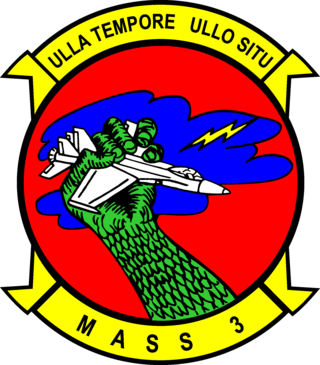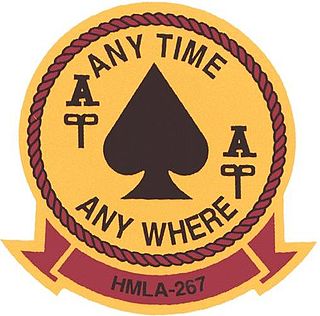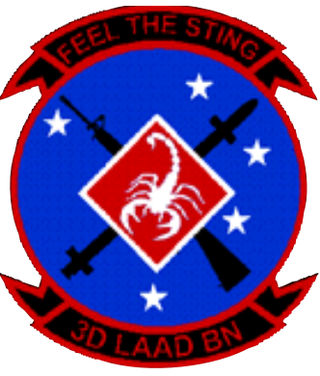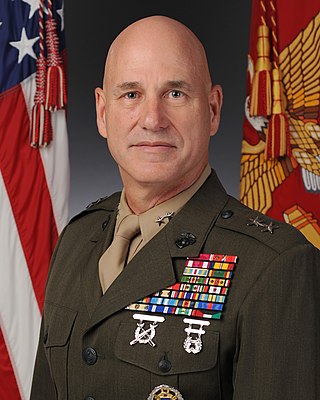
The 4th Marine Division is a reserve division in the United States Marine Corps. It was raised in 1943 for service during World War II, and subsequently fought in the Pacific against the Japanese. Deactivated after the war, the division was re-formed in 1966 and elements of the division deployed during the Gulf War in 1990–1991, as well as during the Iraq War. It is currently the ground combat element of the Marine Forces Reserve and is headquartered in New Orleans, Louisiana, and has units throughout the United States.

The I Marine Expeditionary Force is a Marine Air Ground Task Force (MAGTF) of the United States Marine Corps primarily composed of the 1st Marine Division, 3rd Marine Aircraft Wing, and 1st Marine Logistics Group. It is based at Marine Corps Base Camp Pendleton.

Marine Air Support Squadron 3 (MASS-3), is a United States Marine Corps aviation command and control unit that provides the Direct Air Support Center (DASC) for the 1st Marine Expeditionary Force. They are based out of the 32 Area on Marine Corps Base Camp Pendleton, California and fall under the command of Marine Air Control Group 38 and the 3rd Marine Aircraft Wing.

Marine Light Attack Helicopter Squadron 267 (HMLA-267) is a United States Marine Corps helicopter squadron consisting of Bell AH-1Z Viper attack helicopters and Bell UH-1Y Venom utility helicopters. Nicknamed the "Stingers", the squadron is based at Marine Corps Air Station Camp Pendleton, California and falls under the command of Marine Aircraft Group 39 (MAG-39) and the 3rd Marine Aircraft Wing.

3rd Battalion, 11th Marines (3/11) is an artillery battalion comprising three firing batteries, a Liaison Unit, and a headquarters battery. The battalion is based at the Marine Corps Air Ground Combat Center Twentynine Palms, California and its primary weapon system is the M777 lightweight howitzer with a maximum effective range of 25 miles. They fall under the 11th Marine Regiment and the 1st Marine Division.

1st Light Armored Reconnaissance Battalion is a fast and mobilized armored terrestrial reconnaissance battalion of the United States Marine Corps. Nicknamed the "Highlanders," their primary weapon system is the LAV-25 Light Armored Vehicle armed with the M242 25mm Bushmaster chain gun. They fall under the command of the 1st Marine Division and the I Marine Expeditionary Force. The unit is based out of the Marine Corps Base Camp Pendleton, California.

The 1st Marine Logistics Group is a logistics unit of the United States Marine Corps and is headquartered at Marine Corps Base Camp Pendleton, California, with several subordinate elements located at Marine Corps Air Station Yuma and Marine Corps Air Ground Combat Center Twentynine Palms. It is the logistics combat element of the I Marine Expeditionary Force.

2nd Light Armored Reconnaissance Battalion is a fast and mobilized armored terrestrial reconnaissance battalion of the United States Marine Corps. Their primary weapon system is the 8-wheeled LAV-25 and they fall under the command of the 2nd Marine Division and II Marine Expeditionary Force. The unit is based out of the Marine Corps Base Camp Lejeune, North Carolina. The current mission statement of the battalion is: To perform combined arms reconnaissance and security missions in support of the Ground Combat Element (GCE) of a Marine Air-Ground Task Force (MAGTF). Its mission is to conduct reconnaissance, security and economy of force operations, and, within its capabilities, limited offensive or defensive operations that exploit the unit's mobility and firepower.

Marine Medium Tiltrotor Squadron 268 (VMM-268) is a United States Marine Corps helicopter squadron consisting of MV-22 transport. The squadron, known as the "Red Dragons", is based at Marine Corps Base Hawaii, Kaneohe, Hawaii and falls under the command of Marine Aircraft Group 24 (MAG-24) and the 1st Marine Aircraft Wing.

1st Battalion, 5th Marines (1/5) is an infantry battalion in the United States Marine Corps based out of Marine Corps Base Camp Pendleton, California consisting of approximately 800 Marines and sailors. Nicknamed Geronimo, it falls under the command of the 5th Marine Regiment and the 1st Marine Division. The battalion was formed in 1914 and has served in every major conflict that the United States has been involved in since then.
In the United States Marine Corps, a Marine Air–Ground Task Force is the principal organization for all missions across the range of military operations. MAGTFs are a balanced air–ground, combined arms task organization of Marine Corps forces under a single commander that is structured to accomplish a specific mission. The MAGTF was formalized by the publishing of Marine Corps Order 3120.3 in December 1963, "The Marine Corps in the National Defense, MCDP 1-0". It stated:
A Marine air–ground task force with separate air ground headquarters is normally formed for combat operations and training exercises in which substantial combat forces of both Marine aviation and Marine ground units are included in the task organization of participating Marine forces.

2nd Battalion, 11th Marines (2/11) is an artillery battalion comprising four firing batteries and a Headquarters Battery. The battalion is stationed at Marine Corps Base Camp Pendleton, California. Its primary weapon system is the M777 lightweight howitzer. The battalion was the first in the Marine Corps to fully transition from the M198 Howitzer. They fall under the command of the 11th Marine Regiment and the 1st Marine Division.

5th Battalion, 11th Marines (5/11) was a High Mobility Artillery Rocket System (HIMARS) battalion consisting of four Firing Batteries and a Headquarters Battery. The battalion is stationed at Marine Corps Base Camp Pendleton, California. It is the first active duty HIMARS Unit in the Marine Corps. They fall under the command of the 11th Marine Regiment and the 1st Marine Division. This is the only battalion in the 11th Marine Regiment not using the M777A2 lightweight howitzer.

The 7th Engineer Support Battalion is an engineer support unit of the United States Marine Corps and is headquartered at Marine Corps Base Camp Pendleton, California. The unit falls under the command of 1st Marine Logistics Group and the I Marine Expeditionary Force.

The 15th Marine Expeditionary Unit is one of seven such units currently in existence in the United States Marine Corps. The Marine Expeditionary Unit (MEU) is a Marine Air Ground Task Force (MAGTF) with a strength of about 2,200 personnel. The MEU consists of a command element, a reinforced infantry battalion, a composite helicopter squadron and a combat logistics battalion. The 15th MEU is currently based out of Marine Corps Base Camp Pendleton, California.

The 3d Low Altitude Air Defense Battalion is an air defense unit of the United States Marine Corps currently responsible for providing short range air defense. The battalion falls under the command of Marine Air Control Group 38 (MACG-38) and the 3rd Marine Aircraft Wing and is currently based at Marine Corps Base Camp Pendleton, California.

Combat Logistics Battalion 15 (CLB-15) is a military logistics battalion in the United States Marine Corps based out of Camp Pendleton, California. It consists of approximately 275 Marines and Sailors. It is part of Combat Logistics Regiment 17 within the 1st Marine Logistics Group, I Marine Expeditionary Force. When assigned under the operational control of the 15th Marine Expeditionary Unit, it becomes the Logistics Combat Element (LCE) providing expeditionary combat logistics support to all supported elements of the Marine Expeditionary Unit. CLB-15 has two sister MEU CLBs also based out of Camp Pendleton: CLB-11 and CLB-13.

4th Civil Affairs Group is a civil affairs unit of the United States Marine Corps. It is based in Hialeah, Florida. For information on 4th CAG prior to 2012, see 2nd Civil Affairs Group, which was formed out of the original 4th CAG in Washington D.C. It is one of only four civil affairs groups in the Marine Corps, all of which are reserve units. 4th CAG was the first civil affairs group in the Marine Corps and mostly supports II MEF.

3rd Civil Affairs Group is a civil affairs (CA) unit of the United States Marine Corps based at Naval Station Great Lakes, Illinois. The Marine Corps assigns civil affairs as a primary military specialty for enlisted and additional specialty for officers. The Marine Corps uses its own civil affairs doctrine and runs the Marine Corps Civil-Military Operations School at Marine Corps Base Quantico to train civil affairs Marines.

Paul W. Brier is a retired United States Marine Corps major general. A combat veteran of the Persian Gulf, Iraq, and Afghanistan wars, he retired on 31 December 2016, completing 36 years of military service. He holds a BS in Civil Engineering from the Virginia Military Institute and a Master of Strategic Studies from the U.S. Army War College. A 2012 CAPSTONE Fellow at the National Defense University, he is a graduate of the Defense Resources Management Institute, Naval Postgraduate School; Air War College; Joint Forces Staff College; and Marine Corps Command and Staff College.





























